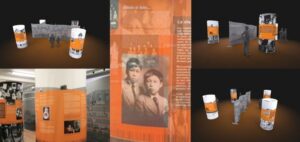National Indigenous Exhibit Coming to Algonquin College
Posted on Tuesday, September 21st, 2021
Algonquin College is pleased to welcome a national exhibit to its Ottawa campus to educate and inform its students. The Legacy of Hope Foundation’s display Generations Lost: Healing the Legacy of Residential Schools will be on display in in front of Nawapon, the College’s Indigenous Learning Commons located in the DARE District, C Building, from September 27 – October 7. Members of the College community who are on campus are invited to view the exhibit at their convenience.
Foundation’s display Generations Lost: Healing the Legacy of Residential Schools will be on display in in front of Nawapon, the College’s Indigenous Learning Commons located in the DARE District, C Building, from September 27 – October 7. Members of the College community who are on campus are invited to view the exhibit at their convenience.
The Legacy of Hope Foundation is a national Indigenous charitable organization with the mandate to educate and create awareness and understanding about the Residential School System. This includes the intergenerational impacts such as the removal of generations of Indigenous children from their families, including the Sixties Scoop, the post-traumatic stress disorders that many First Nations, Inuit, and Metis continue to experience, all while trying to address racism, foster empathy and understanding and inspire action to improve the situation of Indigenous Peoples today. The LHF supports the ongoing healing process of Residential School Survivors, and their families and seeks their input on projects that honour them.
“The goal is for us to education Canadians about Indigenous historical and all the colonial things that happened, said Teresa Edwards, executive director of the Legacy of Hope Foundation. “People were not taught in schools in comprehensive way, the teaching not mandatory and students were saying they haven’t learned about indigenous stories. Education will create people who are knowledgeable about the atrocities that led to abuse and all other issues. Having that knowledge inspires people to take different action.”
The exhibit is just the beginning in terms of education. “We educate about the harm that happened and share the statistics, but also we also talk about positive contributions to the foundations of this country,” said Edwards. “Our Indigenous communities were thriving for thousands of years and didn’t have generations of children of attending residential schools.”
Edwards said the exhibit helps to create understanding and inspires people to ask what they can do. “We have lists of suggested actions people can take as an individual, a group, or as a family. You learn how you can become an ally.”
About the Exhibit
For several centuries, Indigenous children were taken from their homes and communities and placed in institutions called Residential Schools. These schools were run by religious orders in collaboration with the federal government and were attended by children as young as four or five years of age.
Separated from their families and prohibited from speaking their native languages and practicing their culture, the vast majority of the over 150,000 children that attended these schools experienced neglect and suffering. The impacts of sexual, mental, and physical abuse, shame, and deprivation endured at Residential Schools continue to affect generations of Survivors, their families, and communities today.
Remarkably, in the face of this tremendous adversity, many Survivors and their descendants have retained their language and their culture and continue to work toward healing and Reconciliation. This is likely due to their traditional and cultural beliefs, teachings and way of life prior to attending Residential Schools.
Learn more at https://legacyofhope.ca/.
- Posted in
- TRI News